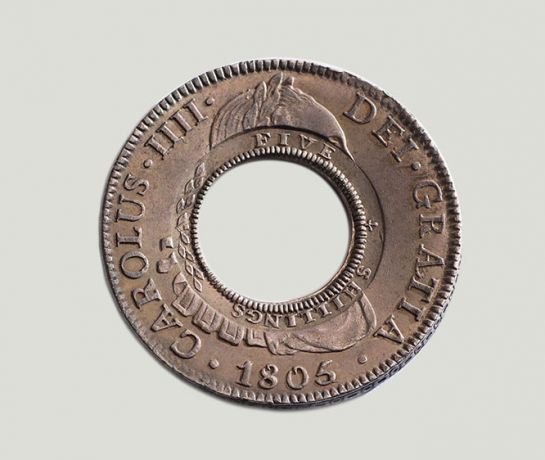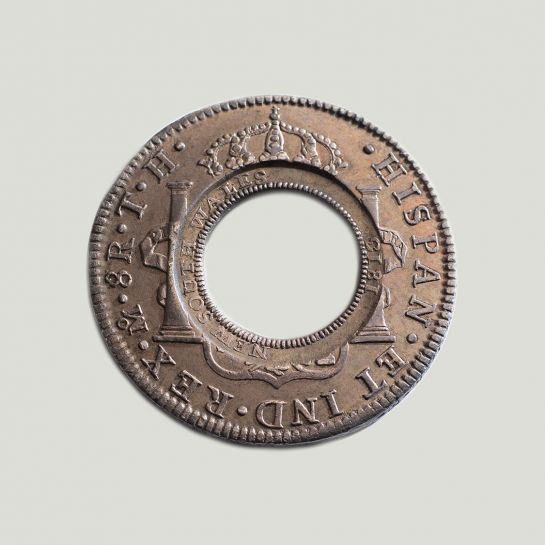Holey Moley! Coinworks realised $1.6 million in sales of Holey Dollars between October 2019 and January 2020. The mammoth tally involves seven coins.

Two out of the seven Holey Dollars sold at $70,000 and $90,000 respectively. And a third at $115,000.
Our comment here being that there is a genuine shortage of Holey Dollars being offered below the $125,000 price point. The very reason why these coins were snapped up.
In fact, the three coins sold on the same day, within hours of their release. While I would like to think it was an industry record, it is certainly, a Coinworks record.
Once you do the math and subtract the three Holey Dollars (total value of $275,000) out of the $1.6 million total sales, you gain an appreciation of the calibre of Holey Dollars that we are selling.
Coinworks sold the finest known Holey Dollar for $480,000. Uncirculated Spanish Silver Dollar and Uncirculated counter-stamps. Collectors should really stop and digest the pure majesty of this coin. (Photo shown below.)
This Holey Dollar was struck on an 1805 Spanish Silver Dollar that was transported to the penal colony of New South Wales in 1812. It nestled somewhere untouched and unused for seven years, until it was delivered to William Henshall. What was it doing in those seven years?
And then after being man-handled by Henshall, holed and over-stamped to become an 1813 Holey Dollar, it lay dormant still unused.
It is in every respect a miracle coin.


While the Holey Dollar shown above is the finest of the 200 privately held Holey Dollars, Coinworks also sold the second finest. Struck on a 1798 Mexico Mint Silver Dollar, this coin is graded at About Uncirculated.
Top quality Holey Dollars are commanding in excess of $400,000 and rightly so.
Not to rest on our laurels, and keen to increase our tally, we will be offering two extremely rare Holey Dollars in late March/April.
- The finest known Transitional Holey Dollar. Graded Extremely Fine, this is a $400,000-plus coin.
- And the second only known example of the very famous Hannibal Head Holey Dollar.
Transitional Holey Dollars were struck from Spanish Silver Dollars that were minted in 1789 and 1790 and are so named because the Spanish Empire was in ‘transition’ at the time due to the death of Charles III. The monarch died on 14 December 1788.
To retain its stance as a world power, Spain demanded that its colonies in the silver-rich continent of South America keep churning out silver dollars. Which required a portrait of a new king.
A royal decree was therefore passed that allowed the Spanish Mints to continue minting coins using the effigy of the deceased king, Charles III. But to acknowledge Charles IV as the new reigning monarch, the legend was modified to CAROLUS IV.
Holey Dollars struck from Transitional Spanish Silver Dollars are extremely rare with only eight known in private hands.
The Holey Dollar being offered is the finest of the privately owned Transitional Holey Dollars and has been exhibited twice, in 2013 at the Macquarie Group Exhibition and again last year at the Royal Australian Mint Canberra. It was sourced decades ago out of Europe through esteemed numismatist, Barrie Winsor.
The vendor has another Holey Dollar in his collection and has elected to keep it. It is the finest known Potosi Mint Holey Dollar, the former property of Dr John Chapman.
The family has made the decision to pass the coin onto their son. The emotional attachment between collectors and Holey Dollars is seen frequently, families passing their prized coins onto the next generation as heirlooms.
Up until a few months ago, only one Hannibal Head Holey Dollar was known. The appearance on the market of this unknown and unrecorded Holey Dollar created huge excitement in the market place.
The Hannibal Head Holey Dollar was created from a Spanish Silver Dollar that had been struck in 1810 at the Lima Mint in Peru, the dollar featuring the legend of Ferdinand VII and an imaginary depiction of the monarch, referred to as the ‘Hannibal Head’ portrait.
The anomaly of the portrait is explained below.
The Spanish Empire was in decline and in 1808, King Charles IV abdicated the Spanish throne for his son Ferdinand VII, the latter reigning for less than two months. Both Charles and Ferdinand were pressured to cede the Spanish throne to Napoleon Bonaparte’s brother Joseph.
The political shenanigans didn't go down well with the Spanish colonial mint in Lima. They refused to acknowledge Joseph Bonaparte as King of Spain.
In what can only be regarded as a protest, the Lima Mint created their own silver dollar with the legend of the imprisoned Ferdinand VII and an ’imaginary portrait’. The portrait was far from flattering and is referred to as the ‘Hannibal Head’ portrait.
Coinworks is working on a new project this year involving Holey Dollars. It will be mammoth and it will foster huge interest in the nation's first coins.
Stay tuned!
© Copyright: Coinworks